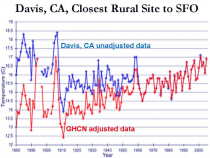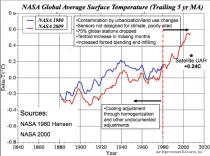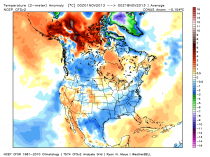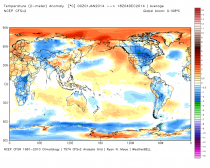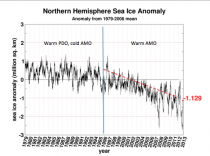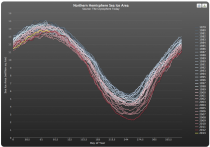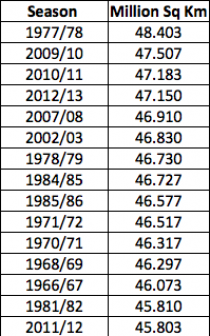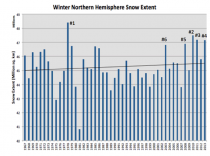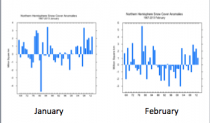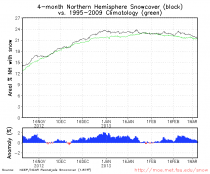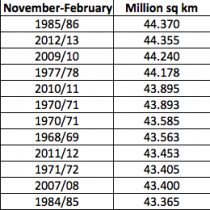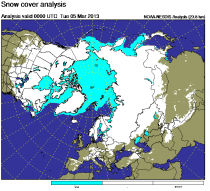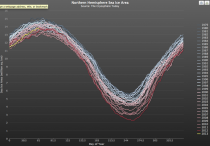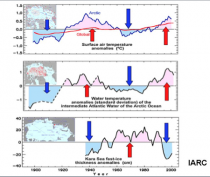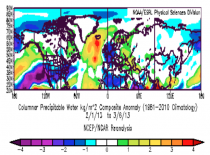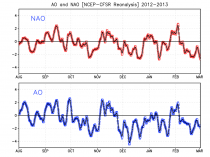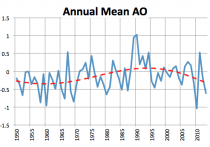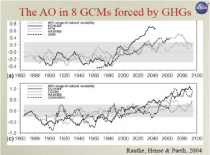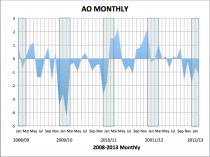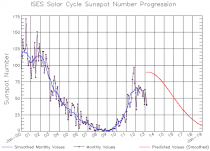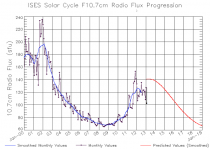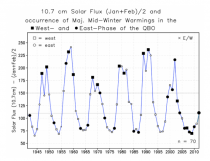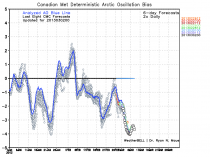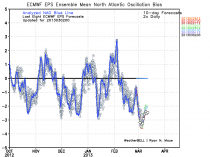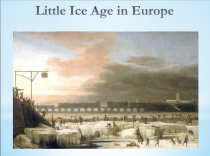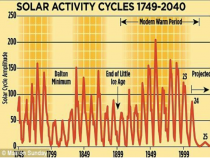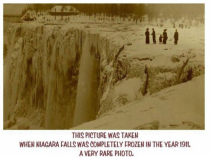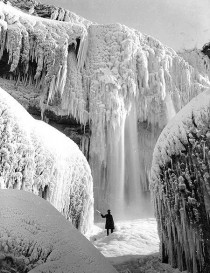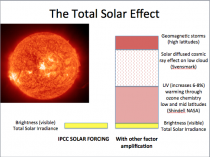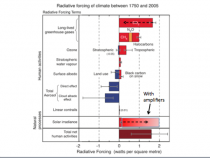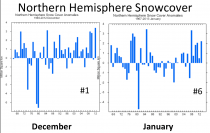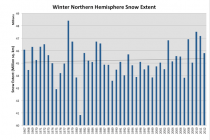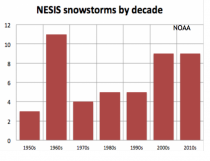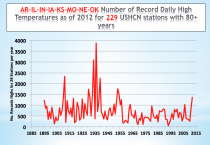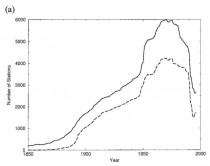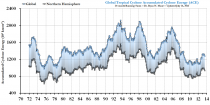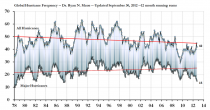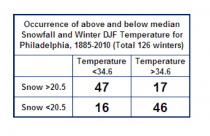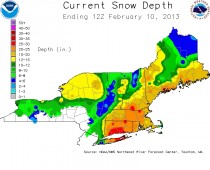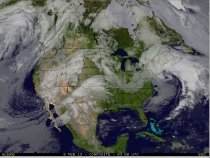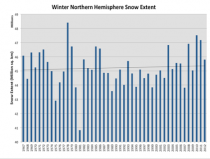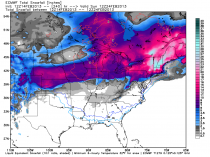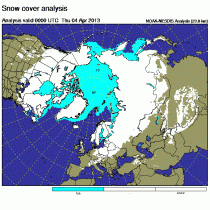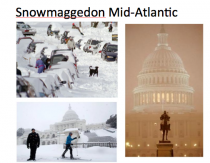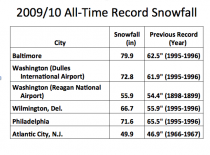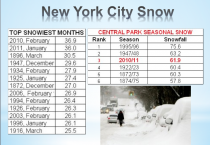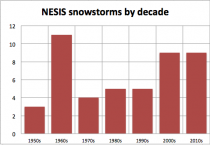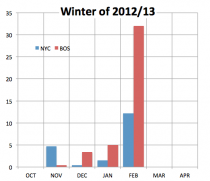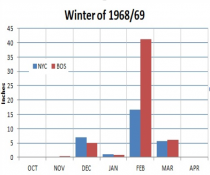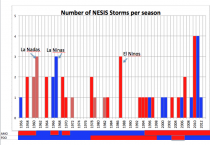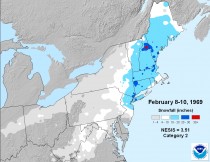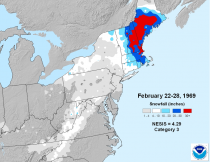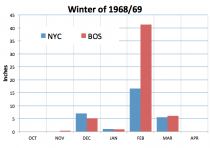WASHINGTON - The military officer charged with monitoring North Korea at a time when the rogue nation is threatening to unleash missile attacks worldwide has used a Senate hearing to double down on his claim that it is global warming that is the real danger.
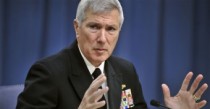
Navy Adm. Samuel Locklear III originally caused a stir just weeks ago when in a speech to scholars at Harvard and Tufts universities in Cambridge, Mass., he said the climate change factor should be the focus of American concern.
At today’s hearing before the Senate Armed Services Committee he defended his assessment that global warming is the greatest threat to security in that part of the world.
According to the Boston Globe, Locklear said earlier, “significant upheaval related to the warming planet… is probably the most likely thing that is going to happen ...that will cripple the security environment, probably more likely than the other scenarios we all often talk about.”
At today’s hearing, Sen. James Inhofe, R-Okla., challenged him, and the admiral doubled down.
Locklear said 70 percent of the world’s expected growth will be in East and South Asia and it “will be moving along the coastal centers” it serves as a possible form of regional destabilizing via population displacement because of rising oceans.
But Inhofe pointed out that scientists disagree with the notion that the climate is changing. He furthermore said that such a belief is one that is held by “environmentalist extremists” who “do not believe in” having a large military.
He said he “cannot recall a time where the world was more dangerous” and Barack Obama’s military cuts are naive and put the U.S. forces “at risk.”
The idea of anthropological climate change has been the focus of many studies and reports in recent years. In 2007, WND reported that a study released by the Danish National Space Center suggested that “the sun still appears to be the main agent in global climate change” rather than by man.
Furthermore, last week WND reported that the scientific journal Science published a report showing dramatic increases in global temperature in the 20th century. While it was touted as a major study, it has now come under scrutiny after scientists involved “quietly admitted that surging temperatures can’t be supported by their data.”
Inhofe himself has been a leading voice challenging the vast assumptions on anthropological climate change. On a related topic, in 2012 Inhofe spoke to WND, saying that “green extremists” are jeopardizing America’s defense by devoting scarce resources to alternative energy, rather than defense development.
Locklear is the chief of the U.S. Pacific Command.
Read more
See this fact checking analysis on the claims being made about severe weather related to warming (which stopped 15 to 17 years ago). (NCA_DAleo_04-12-13.doc)
A retired Western Washington University professor testified to a Republican-controlled state Senate committee Tuesday that climate change stopped in 1998 and that human-caused greenhouse gases are not responsible for fluctuations in the Earth’s temperatures or melting polar ice caps.
The startling testimony from emeritus professor Don Easterbrook is at odds with an apparent consensus among climate scientists and climate-science literature about human causes behind the the rise in global temperatures over the past century. His testimony came one day after the Legislature sent Gov. Jay Inslee a bill that sets up a legislative work group to study Washington’s best strategy for addressing climate change.
Substitute Senate Bill 5802 creates a four-caucus study panel that will hire a consultant to study state options for cutting greenhouse gas emissions to 1990 levels by 2020, and how best to accomplish that at least cost. Republican Sen. Doug Ericksen of Ferndale, who invited Easterbrook to testify at his committee, could become Senate Republicans’ representative on that panel.
It is unclear what effect Easterbrook’s testimony—and his critique of Inslee’s original bill—will have on that bipartisan study work, if any. But the geology professor’s statements stunned Democratic Sen. Kevin Ranker of Orcas Island and other Democratic members of the Senate Energy, Environment and Telecommunications Committee who listened with skepticism, if not incredulity.
Ranker and Sen. Andy Billig, D-Spokane, took issue with Easterbrook’s assertion that NASA, the National Science Foundation and National Oceanographic and Atmospheric Administration would “manipulate” climate data and create a false impression that climate change is real and that global temperatures are rising. They argued there is an apparent consensus in scientific literature.
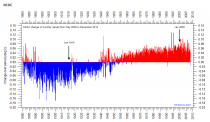
Enlarged. Change in data after 2008 with removal of UHI adjustment and other changes.
“They have frankly tampered with the data ... Mine is the original data,” Easterbrook said at one point. Pressed on this by Ranker, he added it wasn’t anything “scurrilous” done by the science panels but he insisted that data had been “adjusted” in ways that made it less accurate than his interpretations.
ICECAP NOTE: Here is Davis CA, in Barbara Boxer’s district showing the adjustments that created warming from cooling. Then we show the before and after sets with contaminants left in post 1980.
His own reading of data, Easterbrook said, showed there were 20 periods of global cooling and heating over the past 500 years with the most recent cooling trend beginning in 1998 and likely to last up to 25 or 30 years. He asserted that his work was peer reviewed and indicated that he could provide that information to Ranker.
Among Easterbrook’s assertions: that polar ice caps are not melting or shrinking; that sea level not is rising in many places including Neah Bay; that sea water is not becoming acidic due to carbon dioxide, although he said oceanic and Puget Sound waters may be becoming less alkaline as a result of pollutants; and that carbon dioxide is too scarce in the planet’s atmosphere to produce climatic change. All were point-by-point refutations of claims Inslee had made in his own testimony on the bill.
But Ranker wasn’t buying it and at one point said: “The last 12 years were the hottest on record. That’s peer reviewed data I have before me.”
“I can’t answer why it is different,” Easterbrook replied, indicating he was relying on public data he has collected globally. “What I can tell you is this is original data” that had not been adjusted.
Ericksen said before the session that he wanted his committee to operate in an open and fair way and that he believed it is important to hear all sides—and that the public has many views about climate change. He also noted that the presentation comes after Inslee’s climate bill was passed. But Ericksen also questioned Easterbrook’s data at one point—saying that data for the 1930s, which the professor claimed was the hottest period on record—appeared to be cooler than temperatures today.
But in his closing remarks Ericksen thanked Easterbrook and suggested that there are unsettled questions that require lawmakers to look at “all the data that is available to us to make an informed decision.”
“I thought it was a very interesting presentation. I think obviously there are disagreements in Olympia and in the scientific world with regards to the material you presented,” Ericksen said.
Ranker said he hoped Ericksen’s decisions to hear questionable testimony was not a sign that the governor’s climate work group would get derailed. He said the question that needs to be answered is what is the best state response to climate change—not whether it is happening.
“We know conclusively we have had the hottest, days, years, months on record in the last decade or more. It just continues,” Ranker said. “The portrayal that this is a conspiracy—he said that three times to me that the data I’m looking at was manipulated by NOAA and NASA and the National Science Foundation—I find that extremely hard to believe.”
BREAKING NEWS: Hansen to leave NASA
Justin Gillis, NY Times
James E. Hansen, the climate scientist who issued the clearest warning of the 20th century about the dangers of global warming, will retire from NASA this week, giving himself more freedom to pursue political and legal efforts to limit greenhouse gases.
Marveling at the efficiency of a killer in the skies and NASA’s household name on climate change takes his fight for the earth’s future into retirement.
His departure, after a 46-year career at the space agency’s Goddard Institute for Space Studies in Manhattan, will deprive federally sponsored climate research of its best-known public figure. At the same time, retirement will allow Dr. Hansen to press his cause in court. He plans to take a more active role in lawsuits challenging the federal and state governments over their failure to limit emissions, for instance, as well as in fighting the development in Canada of a particularly dirty form of oil extracted from tar sands.
“As a government employee, you can’t testify against the government,” he said in an interview.
Dr. Hansen had already become an activist in recent years, taking vacation time from NASA to appear at climate protests and allowing himself to be arrested or cited a half-dozen times. But those activities, going well beyond the usual role of government scientists, had raised eyebrows at NASA headquarters in Washington. “It was becoming clear that there were people in NASA who would be much happier if the ‘sideshow’ would exit,” Dr. Hansen said in an e-mail.
----------
Jeff Montgomery, The (Wilmington, Del.) News Journal 4:36p.m. EDT March 19, 2013
Personal, economic freedom groups sponsor talk about global warming ‘scare tactics.”

(Photo: Jason Mint, The News Journal, Wilmington, Del.)
STORY HIGHLIGHTS
250 came for the forum with a Harvard-Smithsonian researcher, former Delaware state climatologist
One of them is a member of Delaware’s Sea Level Rise Advisory Committee
Natural coastal erosion is a bigger worry than sea level, he says
GEORGETOWN, Del. - One of the nation’s more controversial climate-change skeptics dismissed warnings about sea-level rise and global warming as “scare tactics” and “sick” science in a talk here.
Willie Soon, a researcher at the Harvard-Smithsonian Center for Astrophysics, and Professor David Legates of the University of Delaware, a former climatologist for the state, bluntly rejected leading climate change claims during the Monday event organized by two nonprofit groups that promote personal and economic freedoms, the Positive Growth Alliance of Millsboro, Del. and the Caesar Rodney Institute of Dover, Del.
“They’re a very sick group,” Soon said. “They’re not talking about science at all. It is all agenda-driven, science results."”
The comments came during a session that one organizer later said should be a call to oppose efforts to base land-use and other policies on forecasts of significant, long-term sea-level rise.
Director Richard Collins of the Positive Growth Alliance said the program, which drew about 250 people, was planned to counteract “outrageous” claims about global warming and its consequences.
“You’re going to find out later that there is deliberate deception going on,” Collins said during his introduction of the evening’s speakers.
Collins also is a member of Delaware’s Sea Level Rise Advisory Committee, a group scheduled to release a plan this summer for adapting to climate change in coming decades.
The group, formed by the state Department of Natural Resources and Environmental Control, based its efforts on forecasts of possible sea-level increases of 1.6 to 5 feet in the next century. It has recommended dozens of policies for consideration.
Legates, asked to step down as climatologist in 2011, said state policymakers never asked his opinion on climate change or sea-level rise while he had the position.
He thinks Delaware should focus on responses to severe, natural coastal erosion rather than strict sea-level rise.
“There is no clear signal of sea-level rise in Delaware,” Legates said.
Some environmental groups have pointed to Soon’s and Legates’ ties to organizations financed by fossil fuel and deeply conservative interests, including the George C. Marshall Institute in suburban Washington and the Chicago-based Heartland Institute.
Queue the P Pielke Jr. convenient button which describes most everything enviro groups and the advocacy group UCS say:

Geologic factors, mainly subsidence in coastal areas, account for the apparent and future long-term sea-level rise, Legates said.
The rise “essentially disappears” once subsidence is accounted for, he said, in contrast to warnings that sea-level increases could reach 6 feet by 2100.
“There’s lots of variability,” said Legates, who noted that the United Nations’ Intergovernmental Panel on Climate Change had steadily reduced its sea-level rise estimates in the past decades.
Legates pointed to North Carolina’s recent efforts to develop land-use policies based on accelerating sea-level rise and claimed that developers had used skewed data that eventually undermined the effort.
Secretary Collin P. O’Mara of Delaware Department of Natural Resources and Environmental Control said Thursday that scientific agreement on the process and prospect of global warming, climate change and its link to human activities was “overwhelming.”
“We are past this being a theoretical problem,” O’Mara said. “We’re experiencing exactly what the climate models predict: warming global temperatures, more extreme weather events, sea-level rise.” See BS button above.
“Rather than rehashing settled science, we need to focus our efforts on how to reduce emissions most cost effectively, improve the resiliency of vulnerable communities and strengthen our economy in the process,” he said.
Maureen Leary, a Georgetown resident who attended the session, said she has doubts about the threat despite U.N. studies warning that some amount of damaging warming and sea-level rise already appears unavoidable.
“I’m not sure that I believe the predictions,” Leary said.
By P Gosselin on 22. March 2013
UPDATE: “This March could be the coldest of the last 100 years,” says meteorologist Dominik Jung - See here!
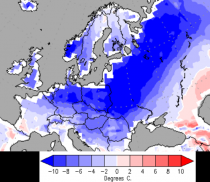
Europe’s bitter cold winter refuses to let up!
For some areas we are now hearing that it is being called the “100-year winter”.
Temperature forecast anomaly for the next 7 days.
For example, Berlin’s online daily Tagesspiegel writes today:
Berlin freezes in 100-year winter.
Lots of snow and bitter cold until the end of March - Berlin hasn’t seen this in more than 100 years.”
Forget the tall tales spread by Mojib Latif. We haven’t forgotten what real winters are. We just haven’t seen anything like this since measurements began in 1895!
The Tagsspeigel writes:
‘There has never been anything like this in Berlin in the last third of March since snow measurements began in 1895,’ says weather expert Friedemann Schenk of the Meteorological Institute for the Freien Universitat (FU).”
The English-language The Local here reports that Germans should not expect spring to arrive anytime soon, as the German Weather Service (DWD) warns that “the record-breaking wintry weather will continue until Easter”.
This weekend will be especially cold. T online news site writes:
In the east, temperature readings will drop dramatically - many readings will be -10C, as low as -13C in some spots. “Some cold records for end of March will fall,” prophesies Ruhnau.”
Germany’s RBB forecasts temperatures down to -15C! The extreme cold overall will make this March in Central Europe the coldest and snowiest in over 40 years at least.
The Local adds:
Record-breaking levels of snow fell in other areas of the northeast namely in Laage, Mecklenburg Western-Pomerania, where a blanket of 27 centimetres of snow smashed the region’s previous 2005 record for the time of year by six centimetres. “For March 20th, the amounts are impressively high,” said Simon Tripper, a meteorologist from the DWD, on Wednesday afternoon.
See two part series on climate change and politics with Art Horn and I and Bryan Donavan. Part Ii is shown first.
Alarmists are trying to blame the cold and snowy winter on lack of arctic ice which they claim results in more blocking. Even my friend Tom Skilling has bought into this nonsense. The arctic ice has a strong correlation with Atlantic warm and cold cycles. The current warm cycle which began in 1995 led to gradual decline in arctic ice. The AMO also correlates with blocking. Whats more important is that is summer ice reduction. The ice has recovered to the middle of the pack by late fall.
By Joseph D’Aleo, CCM
Rutger’s monthly snow data is in. November was 5th snowiest, December was the snowiest ever, January the 6th snowiest and February 16th snowiest. The winter as a whole was 4th snowiest.
As a whole the winter ranked 4th behind 1977/78, 2009/10, 2010/11, (2012/13) and ahead of 2007/08 and 2002/03. That means 5 of the top six snowiest winters for the northern hemisphere have occurred since 2002/03. When i averaged Novermber to February, 2012/13 jumped to #2.
In the November to February average, 2012/13 jumped to #2.
If the snow keeps coming the next few weeks, I suspect November to March will become #1.!!!!
Oh and the arctic ice is near the middle of the pack. Still given the warm AMO, it should be low again next summer. The AMO is the driver for the cyclical changes in ice (see more here).
By the way, to counter the alarmist knee jerk claims that this is due to warm air which means more moisture which means more snow, here is the mean precipitable water for the northern hemisphere since February 1, when it turned snowy in the U.S. As you would expect when it gets cold, (necessary for snow), the amount of water vapor in the air drops. Blues are below normal, yellows and reds above.
Update: See this YOUTUBE video with Nir Shaviv on solar vs AGW
By Joseph D’Aleo, AMS Fellow, CCM
The AO and NAO has been predominantly negative this winter continuing a trend sine the 1990s. It has produced a brutal winter in Russia, especially Siberia into northern and sometimes central China with cold spells and snow in Europe and the United States.
After a rebound last year, we seem to be still on a trend down since 1990. Climate models had indicated an upward trend.
Note how the AO which reached record low levels in 2009/10 winter rebounded late in the 2010/11 winter and stayed higher in 2011/12 before falling again this year.
That matches the solar cycle which bottomed out from 2007/08 through 2009/10 before spiking late in 2010/11 and peaking at the start of the 201/12 winter. it has fallen since and February came in with a SSN of just 38, well below the forecast (red).
Solar flux too dropped to 104 sfus at a time we are supposed to be near solar max for this cycle.
Notice how stratospheric warmings, which produce high latitude blocking and a negative AO and last for 4 to 6 weeks which were rare and mostly near max and min have been almost every years since the sun went ‘asleep’.
The AO and NAO are forecast to stay very low.
NASA SHOWED A CONNECTION OF THE SUN WITH NAO
Shindell et al in the following NASA Earth Observatory story a decade ago related the Maunder Minimum conditions and blocking to the low solar ultraviolet which through ozone chemistry warms the upper atmosphere in low and middle latitudes. When the sun is quiet the UV which changes 6-8% in the 11 year cycle stays near solar minimum levels. The solar flux is said to be a good proxy for the UV.
See the temperatures their ozone/UV model showed for the Maunder Minimum versus normal solar times. See the - NAO!!
Here is what they wrote:
Many things can change temperatures on Earth: a volcano erupts, swathing the Earth with bright haze that blocks sunlight, and temperatures drop; greenhouse gases trap heat in the atmosphere, and temperatures climb. From 1650 to 1710, temperatures across much of the Northern Hemisphere plunged when the Sun entered a quiet phase now called the Maunder Minimum. During this period, very few sunspots appeared on the surface of the Sun, and the overall brightness of the Sun decreased slightly. Already in the midst of a colder-than-average period called the Little Ice Age, Europe and North America went into a deep freeze: alpine glaciers extended over valley farmland; sea ice crept south from the Arctic; and the famous canals in the Netherlands froze regularly - an event that is rare today.
The impact of the solar minimum is clear in this image, which shows the temperature difference between 1680, a year at the center of the Maunder Minimum, and 1780, a year of normal solar activity, as calculated by a general circulation model. Deep blue across eastern and central North America and northern Eurasia illustrates where the drop in temperature was the greatest. Nearly all other land areas were also cooler in 1680, as indicated by the varying shades of blue. The few regions that appear to have been warmer in 1680 are Alaska and the eastern Pacific Ocean (left), the North Atlantic Ocean south of Greenland (left of center), and north of Iceland (top center).
If energy from the Sun decreased only slightly, why did temperatures drop so severely in the Northern Hemisphere? Climate scientist Drew Shindell and colleagues at the NASA Goddard Institute for Space Studies tackled that question by combining temperature records gleaned from tree rings, ice cores, corals, and the few measurements recorded in the historical record, with an advanced computer model of the Earth’s climate. The group first calculated the amount of energy coming from the Sun during the Maunder Minimum and entered the information into a general circulation model. The model is a mathematical representation of the way various Earth systems -ocean surface temperatures, different layers of the atmosphere, energy reflected and absorbed from land, and so forth -interact to produce the climate.
When the model started with the decreased solar energy and returned temperatures that matched the paleoclimate record, Shindell and his colleagues knew that the model was showing how the Maunder Minimum could have caused the extreme drop in temperatures. The model showed that the drop in temperature was related to ozone in the stratosphere, the layer of the atmosphere that is between 10 and 50 kilometers from the Earth’s surface. Ozone is created when high-energy ultraviolet light from the Sun interacts with oxygen. During the Maunder Minimum, the Sun emitted less strong ultraviolet light, and so less ozone formed. The decrease in ozone affected planetary waves, the giant wiggles in the jet stream that we are used to seeing on television weather reports.
The change to the planetary waves kicked the North Atlantic Oscillation (NAO) - the balance between a permanent low-pressure system near Greenland and a permanent high-pressure system to its south - into a negative phase. When the NAO is negative, both pressure systems are relatively weak. Under these conditions, winter storms crossing the Atlantic generally head eastward toward Europe, which experiences a more severe winter. (When the NAO is positive, winter storms track farther north, making winters in Europe milder.) The model results, shown above, illustrate that the NAO was more negative on average during the Maunder Minimum, and Europe remained unusually cold. These results matched the paleoclimate record.
Note: The Maunder Minimum was followed by quiet periods in the 106 and 212 cycles shown as the Dalton Minimum and the early 1900 quiet era.
A quiet sun leads to more -NAO, more cold winter weather. We may be entering at least a Dalton like Minimum, but even if it was like the early 1900s, it could get very cold after the Atlantic follows the Pacific into its cold phase with the low solar (next minimum due around 2020).
See Niagara Falls in 1911.
The solar brightness (visible changes only 0.1% in the 11 year cycle), but there are significant amplifiers. We do not have a good estimate of their magnitude but they are much greater than the brightness. They include the UV discussed, the diffusion of cosmic rays which affects the nucleation of low clouds (Svensmark effect) and geomagnetic which produces warming in higher latitudes (ionization visible as the aurora).
This suggest the IPCC has greatly underestimated the solar effect while the flattening of temperatures for 17 years as per Pachauri and the Hadley center suggest they have seriously overestimated ANY greenhouse warming from CO2. I don’t profess to know exactly what the number are but the arrows suggest the direction.
So if the sun continues in its doldrums, we should see more interesting winters. Europe and Asia have had some brutal cold the last 5 years and very heavy snows. Many European scientists are said to be baffled, bewildered and confused by the cold not forecast by their super computer models and some are beginning to believe they don’t understand the climate they way they thought they did. We have had 4 of the top 5 snowiest winters for the hemisphere for the last decade. Remember the forecasts that snow would become a rare commodity.
Wait until the AMO follows the PDO negative with the quiet sun for broad North American cold, but it should be interesting and snow should be in the picture most years.
We have not gotten the winter ranking yet, but I would guess 2012/13 will rank high up given December was snowiest ever for the hemisphere and January #6. We were well above in February too.
Let’s se if we can add another to the NESIS list. I have added the early February blizzard. If we had a comparable list from NOAA for the central, we might have had one or two this past month and maybe another to come.
By Anthony Watts,. Watts Up With That
A couple of days ago there was this PR from the University of Illinois at Urbana-Champaign. Icecap Note: Announcing the continuing ignorance on parade tour Wuebbles has been on even to the equally clueless Boxer committee with equally clueless other speakers
I decided it was just too ridiculous to get any traction. I was wrong, an even more ridiculous press release followed this one. Only one problem; Wuebbles doesn’t understand the difference between reality and reporting bias- Anthony
University of Illinois atmospheric sciences professor Donald Wuebbles will present a talk about how climate change is increasing the number of severe weather events at the 2013 AAAS meeting.
Climate change’s costly wild weather consequences
CHAMPAIGN, Ill. - Throughout 2012, the United States was battered by severe weather events such as hurricanes and droughts that affected both pocketbooks and livelihoods. Research suggests that in the coming years, U.S. five-day forecasts will show greater numbers of extreme weather events, a trend linked to human-driven climate change.
Donald Wuebbles, a professor of atmospheric sciences ![]() at the University of Illinois at Urbana-Champaign, will discuss extreme weather in a presentation Feb. 15 at the annual meeting of the American Association for the Advancement of Science in Boston.
at the University of Illinois at Urbana-Champaign, will discuss extreme weather in a presentation Feb. 15 at the annual meeting of the American Association for the Advancement of Science in Boston.
In recent decades, multi-day heat waves and severe precipitation have become more frequent. For example, in the U.S. in the 1950s, the number of days that set record high temperatures was equal to the number of days that set record low temperatures. By the 2000s, the United States was twice as likely to see a record high as a record low.
“Human-driven climate change is in fact driving changes in severe weather, and that leads to a lot of potential impacts in both humans and wildlife that end up being costly in many different ways,” Wuebbles said.
As the global climate changes, normal weather patterns are altered. This is because the increasingly warmer atmosphere holds larger amounts of water vapor, which energizes storms, Wuebbles said.
The consequences of severe weather are much greater than the disappointment of a missed picnic or the inconvenience of a power outage. Weather-related disasters incur huge expenses, taxing both public funds and private equity. According to the National Oceanic and Atmospheric Administration, 11 extreme weather events costing more than $1 billion each occurred in 2012.
“What we’ve seen in general is that the number of billion-dollar events has increased over the last three decades,” Wuebbles said. “It’s not just hurricanes, it’s really a number of different types of weather extremes that are increasing, and that’s what the worry is.”
In his talk, Wuebbles will discuss the current understanding of severe weather in relation to the science of climate change, as well as speak about the issues and uncertainties that will affect the U.S. and world in the coming years.
----------
OK today we have this press release from AAAS:
Scientists Say Wild Weather Is Here to Stay
Cable news junkies, take heart: if you love wall-to-wall coverage of hurricanes, wildfires and superstorms, your future viewing schedules will be jam-packed.
Researchers at the AAAS Annual Meeting said that wild weather events like Superstorm Sandy and the severe Texas drought are the new normal in North America, as human-driven climate change has made these events more intense and more frequent.
This GOES-13 satellite image was captured on Oct. 31 at 1240 UTC as Sandy’s circulation was winding down over Pennsylvania. Sandy had been downgraded a remnant low pressure area. Credit: NASA GOES Project
Consider these facts:
- In the 1950s, the number of days that set record high temperatures in the U.S. was equal to the number of days that set record low temperatures. By the 2000s, record highs were twice as likely as record low.
- The amount of precipitation falling in the heaviest rain and snow events in the United States has increased by nearly 20% since the 1950s.
- Since the 1970s, the Atlantic Ocean has seen substantial increases in nearly every measure of hurricane activity, from frequency to storm intensity.
“The scientific analyses are now indicating a strong link between changing trends in severe weather events and the changing climate,” said Donald Wuebbles, an atmospheric scientist from the University of Illinois. “Every weather event that happens nowadays takes place in the context of a changed background climate.”
“Globally the temperatures are higher, the sea levels are higher, and there is more water vapor in the atmosphere, which energizes storms. So nothing is entirely natural anymore,” he said. “The background atmosphere has changed and continues to change due to human activity.”
Extreme weather took political center stage earlier this week, when U.S President Barack Obama mentioned Superstorm Sandy and other severe weather events in his State of the Union speech.
However, the president was careful to note that “no single event makes a trend” an idea echoed by the researchers at a AAAS news briefing.
“While a particular heat wave may have still have occurred in the absence of human-induced warming,” Wuebbles explained, “it would not have been as hot, or lasted this long, and such events would not occur as frequently.”
Ok Bozo explain the dust bowl of the 1930s and the 7 year drought from 1949 to 1956.
Ecologists and wildlife biologists have been steadily compiling evidence that climate change has profound effects on plants and animals, affecting where they thrive and when they breed or flower, among other events. But University of Texas at Austin biologist Camille Parmesan said some of these changes also can be driven by extreme weather events - even just a few days of extreme heat or rainfall.
Climate change interacts with other factors such as pollution and shrinking habitats to affect plant and animal populations, Parmesan acknowledged. But, she said, studies of coral reefs and other natural habitats suggest that “if we reduce these other human stresses, we actually can increase resilience and resistance in natural ecological systems.”
It remains to be seen whether humans can be similarly resilient in the face of extreme weather, the researchers said. The past holds several examples of other societies that did not fare so well under severe climate change.
Tree-ring records from the American Southwest, for example, suggest that drought during the 13th century may have driven the residents of Mesa Verde, Colorado to flee their fields and homes. “The historical record shows us a community that may have failed environmentally,” said David Stahle, a tree-ring scholar from the University of Arkansas. “We are doing the same thing now in terms of our heavy consumption of water and fossil fuels.”
Wuebbles said he has talked with farmers in the American Midwest who are already changing planting times and seed types in response to recent years of severe drought and floods. And other states are grappling with the financial implications of a future of weather extremes.
Texas State climatologist John Nielsen-Gammon has been tracking the fallout from his state’s ongoing drought, which he said was triggered more by extreme high temperatures than a lack of rainfall.
Reservoirs are at their lowest levels since the 1990s, and the state legislature will meet this spring to discuss a water plan that ensures supplies for the next 50 years. “But it costs $53 billion,” Nielsen-Gammon said, “and there’s presently no mechanism to fund it.”
“Up until this point, climate change has been largely an abstract concept because some of the United States has not seen a large increase in temperatures until just recently,” he added. “The awareness of the importance of dealing with climate change is just now becoming apparent within our state.”
Dr. Wuebbles might do well to read and understand how the march of technology has created a reporting bias in “cable news” providing us with “wall to wall coverage”:
And for his three points, the real facts are in [brackets in blue]:
- In the 1950s, the number of days that set record high temperatures in the U.S. was equal to the number of days that set record low temperatures. By the 2000s, record highs were twice as likely as record low. [Yes, but does Dr. Wuebbles know that most of the weather stations setting new records are NEW stations that have been added since then? See graph below
Above is Figure 2a from NOAA/NCDC Peterson and Vose (1997), showing the change in temperature reporting stations over time for daily mean temperatures (solid line) and min/max temperatures (dotted line). Note that the number of stations added after 1950 was the biggest jump, and with so many new stations, it is logical that they’d set new records for their locations. Combine this with the growth of cities (UHI) and spectacularly poor station siting, and it is not at all surprising there are more warm records than cold.]
- The amount of precipitation falling in the heaviest rain and snow events in the United States has increased by nearly 20% since the 1950s. [Again, this can be explained by the addition of more weather stations after 1950, with more stations with rain and snow gauges added, you’ll see more events due to better spatial coverage. Rain and snow bands can often be very narrow, particularly from thunderstorms, and so catching these is dependent on a station being under the event]
- Since the 1970s, the Atlantic Ocean has seen substantial increases in nearly every measure of hurricane activity, from frequency to storm intensity. [ This is double plus wrong, see the graphs of Global Accumulated Cyclone Energy and Frequency below:
And...finally…
Prof. Roger Pielke Jr. says
Let’s take a step back. The science on climate change, extreme events and disaster costs is clear and unambiguous. You don’t need to take my word for it, you can find the science well summarized in the IPCC SREX. And if you don’t like the IPCC you can find an array of peer-reviewed literature. I am happy to debate this topic with all comers as the data and analyses overwhelming support the claims below.
US floods have not increased over a century or longer (same globally).
US hurricane landfall frequency or intensity have not increased (in US for over a century or longer).
US intense hurricane landfalls are currently in the longest drought (7 years+) ever documented.
US tornadoes, especially the strongest ones, have not increased since at least 1950.
US drought has decreased since the middle of the past century.
US East Cost Winter Storms show no trends (here also).
Disaster losses normalized for societal changes show no residual trends (US, other regions or globally).
The only thing that has increased that is extreme, is Dr. Wuebbles opinions.
See Dr. Richard Keen’s excellent response to the AP story now with graphics here.
Another embarrassing moment for the science brought to you by the AMS, HUFFPO and AP’s Seth Borenstein.
Climate Change And Blizzards May Be Connected, Global Warming Studies Find
With scant snowfall and barren ski slopes in parts of the Midwest and Northeast the past couple of years, some scientists have pointed to global warming as the culprit.
Then when a whopper of a blizzard smacked the Northeast with more than 2 feet of snow in some places earlier this month, some of the same people again blamed global warming.
How can that be? It’s been a joke among skeptics, pointing to what seems to be a brazen contradiction.
But the answer lies in atmospheric physics. A warmer atmosphere can hold, and dump, more moisture, snow experts self annointed but totally clueless say. And two soon-to-be-published studies demonstrate how there can be more giant blizzards yet less snow overall each year. Projections are that that’s likely to continue with man-made global warming.
Consider:
- The United States has been walloped by twice as many of the most extreme snowstorms in the past 50 years than in the previous 60 years, according to an upcoming study on extreme weather by leading federal and university climate scientists. This also fits with a dramatic upward trend in extreme winter precipitation - both rain and snow - in the Northeastern U.S. charted by the National Climatic Data Center.
- Yet the Global Snow Lab at Rutgers University says that spring snow cover in the Northern Hemisphere has shrunk on average by 1 million square miles in the last 45 years.
- And an upcoming study in the AMS Journal of Climate says computer models predict annual global snowfall to shrink by more than a foot in the next 50 years. The study’s author said most people live in parts of the United States that are likely to see annual snowfall drop between 30 and 70 percent by the end of the century. (How sad how fall the AMS has fallen - now just another environmental advocacy group)
“Shorter snow season, less snow overall, but the occasional knockout punch,” Princeton University climate scientist ![]() Michael Oppenheimer said. “That’s the new world we live in.” Oppenheimer was an environmental advocate with the Environmental Defense Fund but went to Princeton to try and legitimize his status - this has happened at many colleges and universities to the detriment of students
Michael Oppenheimer said. “That’s the new world we live in.” Oppenheimer was an environmental advocate with the Environmental Defense Fund but went to Princeton to try and legitimize his status - this has happened at many colleges and universities to the detriment of students
Ten climate scientists say the idea of less snow and more blizzards makes sense: A warmer world is likely to decrease the overall amount of snow falling each year and shrink snow season. But when it is cold enough for a snowstorm to hit, the slightly warmer air is often carrying more moisture, producing potentially historic blizzards.
“Strong snowstorms thrive on the ragged edge of temperature - warm enough for the air to hold lots of moisture, meaning lots of precipitation, but just cold enough for it to fall as snow,” said Mark Serreze, director of the National Snow and Ice Data Center. “Increasingly, it seems that we’re on that ragged edge.” another institutional downgrade
Just look at the last few years in the Northeast. Or take Chicago, which until late January had 335 days without more than an inch of snow. Both have been hit with historic storms in recent years.
Scientists won’t blame a specific event or even a specific seasonal change on global warming without doing intricate and time-consuming studies. And they say they are just now getting a better picture of the complex intersection of man-made climate change and extreme snowfall.
But when Serreze, Oppenheimer and others look at the last few years of less snow overall, punctuated by big storms, they say this is what they are expecting in the future.
“It fits the pattern that we expect to unfold,” Oppenheimer said.
The world is warming so precipitation that would normally fall as snow in the future will likely fall as rain once it gets above the freezing point, said Princeton researcher Sarah Kapnick.
Her study used new computer models failing bigger every dayto simulate the climate in 60 to 100 years as carbon dioxide levels soar. She found large reductions in snowfall throughout much of the world, especially parts of Canada and the Andes Mountains. In the United States, her models predict about a 50 percent or more drop in annual snowfall amounts along a giant swath of the nation from Maine to Texas and the Pacific Northwest and California’s Sierra Nevada mountains.
This is especially important out West where large snowcaps are natural reservoirs for a region’s water supply, Kapnick said. And already in the Cascades of the Pacific Northwest and in much of California, the amount of snow still around on April 1 has been declining so that it’s down about 20 percent compared to 80 years ago, said Philip Mote, who heads a climate change institute at Oregon State University.what a downgrade from George Taylor. Mote has apparently given up on his winter decline of western snowpack theory that got him a seat at the IPCC. He is focusing now on April. This spring reduced snowpack may be explained by lack of volcanic aerosols the last two decades which allows the spring sun to do its thing. More snow has been falling in late fall and winter thanks to the cold PDO since 1998. Recent big snow winters have seen snow persist into summer.
Kapnick says it is snowing about as much as ever in the heart of winter, such as February. But the snow season is getting much shorter, especially in spring and in the northernmost areas, said Rutgers’ David Robinson, a co-author of the study on extreme weather that will be published in the Bulletin of the American Meteorological Society.
The Rutgers snow lab says this January saw the sixth-widest snow cover in the Northern Hemisphere; the United States had an above average snow cover for the last few months. But that’s a misleading statistic, Robinson said, because even though more ground is covered by snow, it’s covered by less snow.
And when those big storms finally hit, there is more than just added moisture in the air, there’s extra moisture coming from the warm ocean, Robinson and Oppenheimer said. And the air is full of energy and unstable, allowing storms to lift yet more moisture up to colder levels. That generates more intense rates of snowfall, Robinson said.”
“If you can tap that moisture and you have that fortuitous collision of moist air and below freezing temperatures, you can pop some big storms,” Robinson said.
As the stories below show, this will join 4 of the top 5 snowiest winters for the hemisphere that fall only behind 1977/78 - 2009/10, 2010/11, 2007/08,. 2002/03) in the last decade. We have had 18 major impact east coast metro snowstorms since 2000, 11 since 2009. The only decade with more major snows was the 1960s, the coldest decade in the last 80 years coming after a two decade warming. Cooling after a warm period is what produces more snows and storms. Winters as shown here have cooled in the last 15 years in all 9 US climate regions.
Dr. Richard Keen has commented in some great detail on the Borenstein piece here and had done a wonderful study here that showed that cold winter produce more snows not warm in Philadelphia.
By Joseph D’Aleo, CCM
In the fall the UCS environMENTAL psuedo-scientists from UNH testified to the NH legislators claiming decreasing snow due to global warming endangering the skiing and maple sugar industry. They did the same atop Mt Washington in 2007, just prior to a record snow year coast to coast.
What a storm clobbered the northeast last week - with up to 40 inches of snow in the northeast, 12 inches in 90 minutes in Connecticut, hurricane force wind gusts along the coast with major coastal flooding.
The radar showed echoes topping 50dbz and satellites had cloud tops over 20,000 feet and as cold as -63C. The heavy convection produced 12 inches in just 90 minutes in one spot in Connecticut and 14 inches in 4 hours in New Haven. See the amazing snow amounts from Boston NWS here and New York City NWS here. Note amounts as high as 40 inches (Hamden, CT).
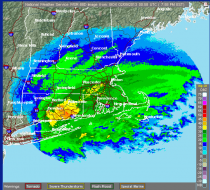
Given that December and January both ranked above 2009/10 and 2010/11 and snowcover continues above normal, suggests 2012/13 will rank in the top 5. Look at the next 10 days according to the Weatherbell.com European model snowfall forecast for the eastern US.
In a television interview today, I was asked whether global warming could explain this. I replied no, we get snow during cold periods not warm. Global warming would reduce the north south contrast and reduce the strength of storms. Also the warming models and IPCC and NOAA claimed warming would take the rain snow line most often near the major cities of the east and push it inland reducing snow for the cities. Not so.
In fact we have had 18 major impact major metro snowstorms in the east since 2000. We have had 11 in the last 4 years.
See the similarity of the winter snows this year in NYC and BOS and 1968/69.
The majority of Spain is covered in knee-deep snow and more than 930 miles worth of roads have been closed as a result, officials said. Madrid, Mancha and Navarra are among the hardest hit regions, thinkSPAIN reported, and areas in the south have already been hit hard or will be soon.
In areas in the western region of Galicia, snow in remote areas has reached as much as 5 feet deep. Meteorologists said snow is expected to hit all areas that are sea-level or higher, accompanied by winds as high as 60 mph. Madrid, the Basque Country, Castilla-La Mancha, Galicia, Asturias, Cantabria, La Rioja and Navarra are the worst-hit regions, as are parts of Castilla y León – including Palencia, Ávila, Burgos, Leoacuten and Segovia; and the provinces of Cáceres in Extremadura; Lleida in Catalunya, and Zaragoza and Huesca in Aragoacuten. In the far south of the country, all of Andalucía except for the Sevilla, Caacutediz, Huelva and Maacutelaga provinces, and Murcia in the south-east have either already been hit by snow or are expected to in the next few days. Snow-chains are needed to drive anywhere outside of major cities in all these areas, and lorries have been banned from the A-1 and A-6 westbound in Madrid. Madrid photo below.
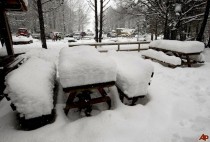
By Joseph D’Aleo, CCM
Although some parts of the hemisphere has seen record snow, the lower 48 has seen a more erratic snow season. February has turned snowy and some big storms are about to start slamming the nation starting Friday.
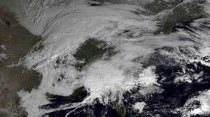
BOSTON (AP) - A blizzard of potentially historic proportions threatened to strike the Northeast with a vengeance Friday, with up to 2 feet of snow feared along the densely populated Interstate 95 corridor from the New York City area to Boston and beyond.
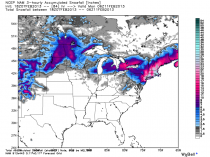
Weatherbell snowfall forecast NAM model. Pale greens in New England and New York are 2 to 3 feet. See Weatherbell.com for much more. We have been talking about this cold stormy period coming the last few weeks. Joe Bastardi and I blog daily and do videos.
From Pennsylvania to Maine, people rushed to stock up on food, shovels and other supplies, and road crews readied salt and sand, halfway through what had been a merciful winter. ICECAP NOTE: And after the fall snow last year was a lean year for snow too. The lull was to be expected after 10 major east coast storms in less than 4 years. Big snows are more common when the Atlantic (AMO) is in its multidecadal warm mode and the Pacific is cold as been the case the last half dozen years and in the 1950s and 1960s.
Before the first snowflake had even fallen, Boston, Providence, R.I., Hartford, Conn., and other New England cities canceled school Friday, and airlines scratched more than 1,700 flights, with the disruptions certain to ripple across the U.S.
Forecasters said this could one for the record books. “This one doesn’t come along every day. This is going to be a dangerous winter storm,” said Alan Dunham, meteorologist for the National Weather Service in Taunton, Mass. “Wherever you need to get to, get there by Friday afternoon and don’t plan on leaving.” The snow is expected to start Friday morning, with the heaviest amounts falling at night and into Saturday. Wind gusts could reach 65 mph. Widespread power failures were feared, along with flooding in coastal areas still recovering from Superstorm Sandy in October. Boston could get more than 2 feet of snow, while New York City was expecting 10 to 14 inches. Mayor Michael Bloomberg said plows and 250,000 tons of salt were being put on standby. To the south, Philadelphia was looking at a possible 4 to 6 inches.
“We hope forecasts are exaggerating the amount of snow, but you never can tell,” Bloomberg said, adding that at least the bad weather is arriving on a weekend, when the traffic is lighter and snowplows can clean up the streets more easily.
Amtrak said its Northeast trains will stop running Friday afternoon. The organizers of New York’s Fashion Week - a closely watched series of fashion shows held under a big tent - said they will have extra crews to help with snow removal and will turn up the heat and add an extra layer to the venue.
Blizzard warnings were posted for parts of New Jersey and New York’s Long Island, as well as portions of Massachusetts, Rhode Island and Connecticut, including Hartford, New Haven, Conn., and Providence. The warnings extended into New Hampshire and Maine.
In New England, it could prove to be among the top 10 snowstorms in history, and perhaps even break Boston’s record of 27.6 inches, set in 2003, forecasters said. The last major snowfall in southern New England was well over a year ago - the Halloween storm of 2011.
Dunham said southern New England has seen less than half its normal snowfall this season, but “we’re going to catch up in a heck of a hurry.” He added: “Everybody’s going to get plastered with snow.” Diane Lopes was among the shoppers who packed a supermarket Thursday in the coastal fishing city of Gloucester, Mass. She said she went to a different grocery earlier in the day but it was too crowded. Lopes said she has strep throat and normally wouldn’t leave the house but had to stock up on basic foods - “and lots of wine.” She chuckled at the excitement the storm was creating in a place where snow is routine.
“Why are us New Englanders so crazy, right?” she said.
At a Shaw’s supermarket in Belmont, Mass., Susan Lichtenstein stocked up, with memories of a 1978 blizzard on her mind. “This is panic shopping, so bread, milk, a snow shovel in case our snow shovel breaks,” she said.
In New Hampshire, Dartmouth College student Evan Diamond and other members of the ski team were getting ready for races at the Ivy League school’s winter carnival.
“We’re pretty excited about it because this has been an unusual winter for us,” he said. “We’ve been going back and forth between having really solid cold snaps and then the rain washing everything away”. But he said the snow might be too much of a good thing this weekend: “For skiing, we like to have a nice hard surface, so it will be kind of tough to get the hill ready.”
Massachusetts Gov. Deval Patrick ordered non-emergency state employees to work from home on Friday and urged private employers to do the same.
Terrance Rodriguez, a doorman at a luxury apartment complex in Boston, took the forecast in stride. “It’s just another day in Boston. It’s to be expected. We[re in a town where it’s going to snow,” he said. “It’s like doomsday prep. It doesn’t need to be. People just take it to the extreme.”
ICECAP NOTE: The year has some similarity to 1968/69, when the snow through January was lean but two major storms including the famous Lindsay Storm and the 100 hour blizzard followed.
CO2isGreen.org: Team of Ex-NASA Scientists Concludes No Imminent Threat from Man-Made CO2
BY PR NEWSWIRE
JANUARY 23, 2013 09:47 AM EST
WASHINGTON, Jan. 23, 2013 /PRNewswire-USNewswire/—A group of 20 ex-NASA scientists have concluded that the science used to support the man-made climate change hypothesis is not settled and no convincing physical evidence exists to support catastrophic climate change forecasts.
Beginning in February 2012, the group of scientists calling themselves The Right Climate Stuff (TRCS) team received presentations by scientists representing all sides of the climate change debate and embarked on an in-depth review of a number of climate studies.
Employing a disciplined approach of problem identification and root cause analysis honed from decades of dealing with life threatening safety issues in successfully sending astronauts up through Earth’s atmosphere and returning them safely home, the TRCS team concluded that no imminent threat exists from man-made CO2.
TRCS team is comprised of renowned space scientists with formal educational and decades career involvement in engineering, physics, chemistry, astrophysics, geophysics, geology and meteorology. Many of these scientists have Ph.Ds. All TRCS team members are unpaid volunteers who began the project after becoming dismayed with NASA’s increasing advocacy for alarmist man-made climate change theories.
H. Leighton Steward, chairman of CO2isGreen.org as well as the educational non-profit, PlantsNeedCO2.org, makes the following comments regarding the TRCS posting.
1. The science of what is causing global climate change or warming is clearly not settled and never has been. 2. There is no convincing physical evidence to support the man-made climate change hypothesis. The standard test of a hypothesis is whether it is supported by real observations, which seems to have been ignored by climate alarmists. 3. Claims made by proponents of catastrophic man-made warming are dominantly supported by non-validated computer models and the output of these models should not be relied upon by policy-makers. Some TRCS team members have been making critical decisions using complex computer models for decades. 4. There is no immediate threat of catastrophic global warming even if some warming occurs. The sea level is not going to suddenly begin a steep acceleration of its 18,000-year rate of rise. Global sea level rise is not currently accelerating despite what climate change alarmists claim. 5. The U.S. Government has overreacted to a possible catastrop hic warming. The probable negative impacts to the economy, jobs and an increased cost of food, transportation and utilities will be severe and hurt the poor and middle class the most. Real experiments show that Earth’s habitats and ecosystems could be damaged if CO2 levels are actually reduced. Environmentalists have been grossly misled to believe CO2 is a pollutant. 6. Empirical evidence shows that Earth is currently “greening” significantly due to additional CO2 and a modest warming. 7. Money saved by abandoning a premature rush to lower CO2 emissions could be better spent by continuing research on alternative energies that are not currently competitive or reliable.
Dr. Harold Doiron, team leader for TRCS and former NASA scientist, along with H. Leighton Steward, will be participating on The Hard Question panel debate on climate change tonight at 5:00pm at The National Press Club, Holeman Lounge (13 th floor) , 529 14 th Street, Washington, DC.
More information can be found at http://www.CO2isGreen.org.
Supporting scientific information can be found at http://www.PlantsNeedCO2.org.
SOURCE CO2isGreen.org
An amazing story from Russia today
Unrelenting snowfalls have caused unprecedented chaos in Russia. Over the past week, the country has seen scores of traffic accidents, flight delays and, in some cases, the complete isolation of some remote settlements and towns.
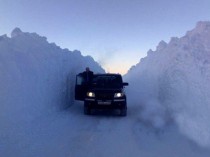
Norilsk (Photo from bigpicture.ru)
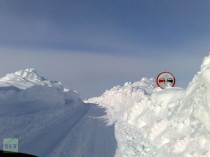
On Friday, Moscow was on a verge of traffic collapse as more than 10 inches of snow fell on the city, which is more than half of January’s average. Thousands of passengers were stranded overnight in the capital’s major airports, as several dozen flights were delayed. Muscovites woke up and found their cars, driveways and houses buried under a thick layer of snow, with city workers unable to get to smaller streets. Moscow’s Yandex app showed traffic at level 10, the highest possible, as strong winds created blizzard conditions and built imposing snow drifts.
Falling snow and ice caused many accidents due to poor visibility and bad road conditions. Moscow witnessed a 13-kilometer jam on MKAD, one of the city’s main highways, reducing speeds to 10 to 25 kph in the capital. More than 12,000 snow removal trucks worked around-the-clock to clean up the mess, but their efforts did little, with the city coming to an effective standstill.
The chair of the Duma’s transport committee called for local transport officials to face legal sanctions for failing to cope with the winter weather. “Until local bureaucrats face the wrath of the law, winter will always be a surprise occurrence. They will continue to do nothing, as people suffer,” Mikhail Bryachak told Kommersant FM radio. However, meteorologists have promised some good news for Moscow: The stormy conditions are expected to recede over the weekend.
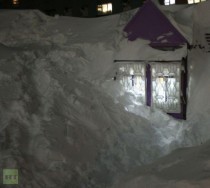
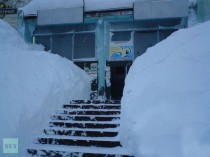
While the snowstorms have caused inconvenience for large population centers in western Russia, they have been life-threatening further east in the country. The polar circle city of Norilsk has been buried under 10 feet of snow, entire apartment blocks, markets, stores and offices were buried under snow overnight.
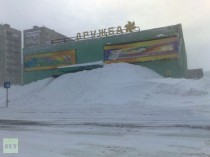
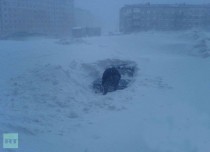
Banks of snow were as high as two people put together, reaching the second-story windows of some apartment buildings. Cars, stores, garages were blocked. Norilsk metropolitan workers were forced to dig passageways through the snow banks to create access between the outside world and the barricaded city. Meanwhile, icicles up to three feet in length have formed off the ledges of buildings, breaking at random and causing a lethal hazard for pedestrians below.
Elsewhere, the extreme weather continues. In the Altai Republic in Western Siberia, 12 Russian settlements were isolated because of the snowstorm. Seven settlements, with a total population of 1,300 people, remain cut off from the outside world due to the snow drifts. Emergency crews are currently en route to deliver needed supplies to the stranded populations. Snow accompanied by strong winds has caused flight delays in the airport of Russia’s far eastern town of Petropavlovsk-Kamchatsky. The runway has been cleared, but planes are not risking takeoff due to strong sidewinds. Flights were also delayed in Russia’s easternmost cities of Vladivostok and Khabarovsk.
More snow storms are predicted in Western Siberia and the Western Urals over the weekend. In the end of 2012, Russia saw extreme winter not witnessed since 1938. The coldest-ever December in Russia led to the evacuation of hundreds of people in Siberia, where temperatures fell below -50 degrees Celsius; Moscow also saw its coldest night ever for the season.
More than 90 Russians died during the cold snap, and more than 600 people were taken to hospital due to the extremely dangerous weather, which is 10 degrees (C) below the December norm. Nearly 200 people have died throughout Russia as a direct result of weather-related accidents and hypothermia this season, according to official statistics, although the extreme conditions have likely contributed to many more fatalities.
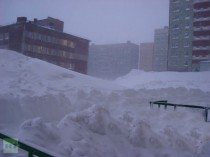
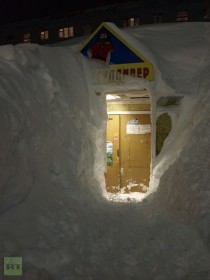
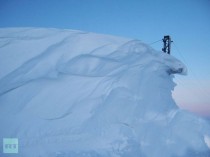
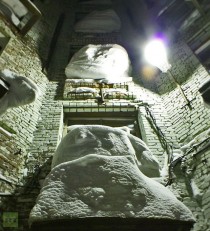
NASA: We May Be On the Verge of a “Mini-Maunder” Event.
All climate scientists agree that the sun affects Earth’s climate to some extent. They only disagree about whether or not the effect form the sun is minor compared to man-made causes.
We noted in 2011:
This week, scientists from the US Solar Observatory and the US Air Force Research Laboratory have discovered - to their great surprise - that the sun’s activity is declining, and that we might experience the lowest solar output we’ve seen since 1645-1715. The Register describes it in dramatic tones:
What may be the science story of the century is breaking this evening.
Scientists who are convinced that global warming is a serious threat to our planet say that such a reduced solar output would simply buy us more time… delaying the warming trend, but not stopping or reversing it.
On the other hand, scientists who are skeptical about global warming say that the threat is a new mini ice age. (Remember that scientists have been convinced in the past that we would have a new ice age, and even considered pouring soot over the arctic in the 1970s to help melt the ice in order to prevent another ice age. Obama’s top science advisor was one of those warning of a new ice age in the 1970s. And see this.)
NASA reports this week that we may be on the verge of another Maunder Minimum (a period with an unusually low number of sunspots, leading to colder temperatures):
Much has been made of the probable connection between the Maunder Minimum, a 70-year deficit of sunspots in the late 17th-early 18th century, and the coldest part of the Little Ice Age, during which Europe and North America were subjected to bitterly cold winters. The mechanism for that regional cooling could have been a drop in the sun’s EUV output; this is, however, speculative.
The yearly averaged sunspot number for a period of 400 years (1610-2010). SOURCE: Courtesy of NASA Marshall Space Flight Center.
The sun could be on the threshold of a mini-Maunder event right now. Ongoing Solar Cycle 24 is the weakest in more than 50 years. Moreover, there is (controversial) evidence of a long-term weakening trend in the magnetic field strength of sunspots. Matt Penn and William Livingston of the National Solar Observatory predict that by the time Solar Cycle 25 arrives, magnetic fields on the sun will be so weak that few if any sunspots will be formed. Independent lines of research involving helioseismology and surface polar fields tend to support their conclusion.
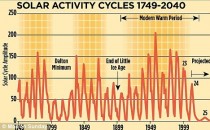
NASA explains that interactions between the sun, sources of cosmic radiation and the Earth are very complicated, and it takes an interdisciplinary team of heliophysicists, chemists and others to quantify what is really going on. And the Earth’s climate is also affected by cosmic radiation.
So even if NASA’s prediction of a period of an unusually low amount of sun spots is proven correct - it is hard to know whether that will lead to a large or small reduction in temperature trends.
Solar Variability and Terrestrial Climate
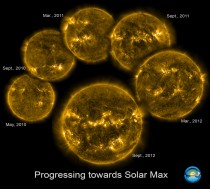
Jan. 8, 2013: In the galactic scheme of things, the Sun is a remarkably constant star. While some stars exhibit dramatic pulsations, wildly yo-yoing in size and brightness, and sometimes even exploding, the luminosity of our own sun varies a measly 0.1% over the course of the 11-year solar cycle.
There is, however, a dawning realization among researchers that even these apparently tiny variations can have a significant effect on terrestrial climate. A new report issued by the National Research Council (NRC), “The Effects of Solar Variability on Earth’s Climate,” lays out some of the surprisingly complex ways that solar activity can make itself felt on our planet.
------------
New paper finds increase in US sunshine has had 4.4 times more effect than greenhouse gases since 1996
A paper published today in the Journal of Geophysical Research - Atmospheres finds that due to a decrease in cloud cover, solar radiation has significantly increased over the US from 1996 to 2011. The authors note the change in longwave (infrared) surface radiation ‘dwarfs the [alleged contribution] from the increase of CO2 during the analysis period.” According to the paper, the natural variability due to changes in sunshine has had 4.4 times greater effect on surface radiation than increased greenhouse gases since 1996 [6.6/1.5 = 4.4]. According to the authors,
The paper adds to many other peer reviewed papers documenting a global decrease in cloud cover or ‘global brightening’ over various periods and locations beginning the the 1980’s. This decrease in cloud cover alone could account for all global warming observed since the ice age scare of the 1970’s. More
by Joe D’Aleo
Interesting weather has been occurring worldwide with snow in the Middle East, earlier frigid weather in Shanghai, snow in Tokyo and continuing brutal weather in Russia and an early heat wave in Australia where the summer monsoon - related to the MUO behavior, was slow to come on.
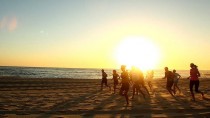
The last Australian heat and drought was in 2009. The strong La Nina of 2010/11 and the follow-up in 2011/12 brought much cooler and wetter conditions. You can see the dryness in the southwest and south the last year not as bad as in 2009. Also reservoirs were near capacity and irrigation was effective for cropping. .
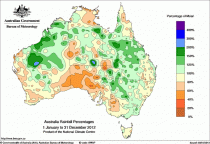
As in the US, the dry winter last year has aggravated the heat central.
Here is the 7 day forecast with heat shrinking to the central.
_thumb.png)
The delayed monsoon, now over Indonesia, would normally be further south and be acting to break up the unremitting heat over central Australia. Darwin, along with much of the country, has had rainfall well below average for the past three months.
“One big question is what’s going to happen to the monsoonal trough,” said Aaron Coutts-Smith, NSW manager of climate services at the bureau. “It’s been a relatively late start to the monsoon.” The weak monsoonal conditions mean northern regions aren’t getting the cloud cover and rainfall that would normally sap some of the heat collecting in the interior.
“That can really put a lid on extreme temperatures,” he said. Sound familiar? That was the story in the US the last two year drought. related to the super La Nina of 2010/11 and the acceleration of global cooling.
An interesting phenomenon occurred similar to the dust storms we see in Arizona at the start of the monsoon season called Haboobs when thunderstorms popped and picked up dust in an awesome display of combined dust and storm clouds.
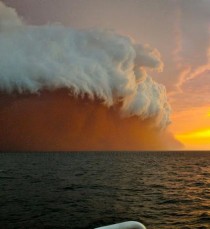
It was reminiscent of the Arizona dust storm (Haboob) in July 2011.
Cooler temperatures arrived in parts of southeastern Australia this Wednesday. This dangerous heat continued until midnight in Sydney after Tuesday’s hot temperature of 47F (about 106F). Hundreds of Sydneysiders went for a swim at midnight with a temperature that was still at 35C (95F). Sydney’s forecasted high temperature for Wednesday was 25C (77F). Surprisingly, snowflakes were flying a bit at Mount Hotham in Victoria Wednesday morning after the hot temperatures the previous day.
In contrast look at the 8 day anomaly chart for Russia, where normals are well below zero (F). Negative anomalies are approaching 40F. Wow. It shows temperatures easing in central Shanghai where frigid cold caused ice problems in Beijing and even at Shanghai with heavy snows in some spots.
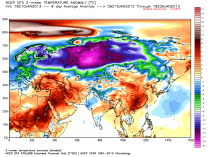
Moscow ice fog, ice bound coastal China, snow in Tokyo and cold in the Middle East and this week Europe and the US.
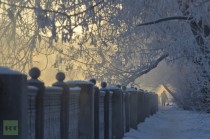
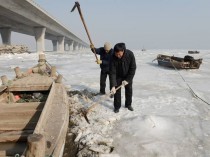
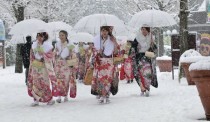
And in Jerusalem, would you believe 8 inches of snow!!!
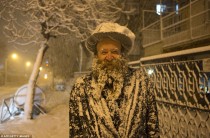
Now you may feel is the time to ‘get it on’ here in the US. Of course, we have not been short of weather stories the past 4 years with 9 major snows for the eastern cities, more for the Pacific Northwest, floods, droughts, heat weaves, Irene and Sandy also related to global cooling and low solar that causes strong persistence of weather patterns and an amplified Rossby wave pattern.
A major stratospheric warming is taking place that should result in 4 to 6 weeks of harsh weather for the Europe and North America. Sub zero cold will afflict Boston and Chicago and single digit mornings in NYC, Philadelphia and Baltimore/Washington. Snows will increase the snowcover again. The hemisphere had a record snowcover for December.

Al Jazeera has acquired Current TV, the progressive cable news station co-founded by Al Gore.

The news was reported by the New York Times’ Brian Stelter on Wednesday. Current had been aggressively looking for a buyer for some months.
Al Jazeera will replace Current’s programming with its own network. The Doha-based channel has long sought to extend the reach of its English-language service in the United States. The deal gives the network the ability to get in front of more American viewers, which has been one of its biggest challenges. Al Jazeera English launched in New York City last year, but has previously faced resistance from cable operators in other parts of the country. Though it remains controversial for many, its reporting from the Middle East during and after the Arab Spring gave it a vastly increased profile - and a new credibility - inside the US.
Sources familiar with the talks told the Times that the channel, called “Al Jazeera America,” will be based in New York, with the majority of its content created in the United States. The rest of the content would come from Al Jazeera’s English-language channel.
Current co-founder Joel Hyatt told staffers that he and Gore were “thrilled” about the deal. In a possible sign of the lingering skittishness over Al Jazeera, he said that Time Warner Cable will not carry the new channel because it had not “consented” to the acquisition. (Some accused Time Warner of political cowardice.) This will leave Al Jazeera with carriage in around 40 million homes.
The purchase brings to an end the many attempts by Gore and his partners to make Current viable over its seven-year existence. The network morphed repeatedly, from a center for short videos to a home for documentary reporting to its last iteration as a staunchly liberal cable news and opinion network. None of the moves proved successful enough. Host Eliot Spitzer put his finger firmly on the problem earlier in December when he told Fishbowl NY, “Nobody’s watching, but I’m having a great time.”
Still, the deal could benefit Gore quite a bit. Forbes estimated that the former vice president could make at least $125 million from the sale.





